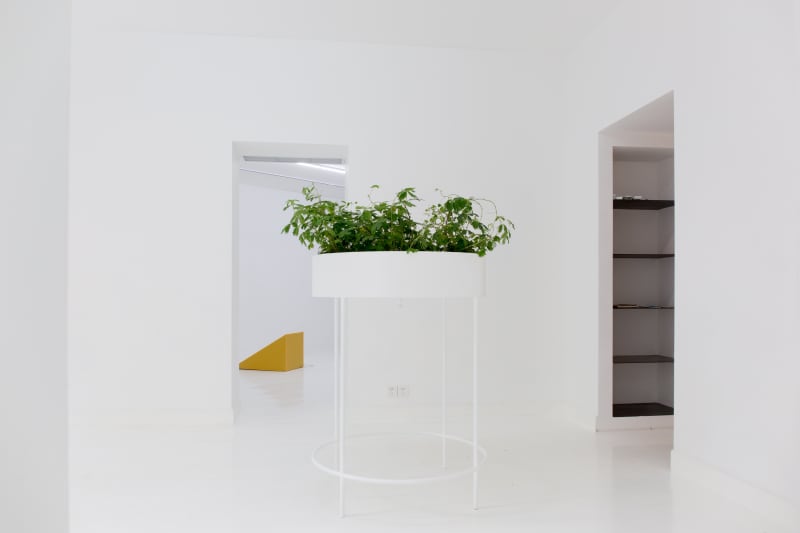Since beginning to exhibit her work, Alice Wang only has one name for her exhibitions: The Earth Is Plummeting Towards The Sun While Just Missing It.
"Why is this the only exhibition title you have ever used?"
"The reason why I believe we are plummeting to our death but at the same time we are not is because I prefer to leave the social, I prefer being alone. I find human nature to be quite oppressive."
"So is this interview something you'd rather not do?"
"Well, I think a little bit. I don't want to completely give everything away through interaction. I do want the challenge to say something but not say anything… My challenge is to get the art critic to find their own language, not in service of something else."
In the furthest room in Capsule Gallery a perfect three-dimensional rectangle stands over two meters high murmuring softly. Its surface is smooth and dull, made of beeswax, but the yellow color is loud in the white room and the shape dominates the space. At eye level, a hole punched through the rectangle shoots a column of gentle wind.
"Wind has always been something I wanted to work with… The physical limits of the sculpture don't end at it's visible limits," Alice says. "I 'see' the other shape jumping out of the structure." Indeed, the piece affects the space around it, and 'seeing' its invisible influence isn't done through sight.
Alice Wang's work does not rely on sight so much as she does on a person's intuition. That said, Alice's work is not easy to access, but it raises worthwhile questions about what art should be. I know what you think, I have thought it too: "intuition" sounds meaningless and like a good way to avoid responsibility over your art. I disagree. True, Alice is reticent to explain her art: her work does not contain titles; her exhibitions are unnamed; the gallery does not include descriptions about her work. But the anonymity of the work does not mean there is no purpose. Alice herself said to me during our interview, "I really don't think of art as a communication device. Art is an experience… I didn't want any linguistic scaffolding. I wanted to throw you into the experience and have you make sense of it on your own. Whatever you get out of it is what it is; I don't think it is important for the audience to get it right away."
Making sense of Alice's work is our job, yours and mine. She is asking a lot from us but it is a worthwhile task because it helps us understand a fundamental question: What is art? This means, what are art's limitations?
So what do we make of Alice's artwork?
"I might be part of a group of artists who do not think art is a referential thing, pointing to something else. The artwork itself is a being." Indeed, Alice's work is kinetic and moves independent from human intervention. For example, the copper patina has an entropic kinesis, seen as brown dust flaking from the surface to reveal a blue sea beneath. The "movement" is a temporal one, consciously put in to motion but given the freedom to move on its own through time. Other pieces, like the mimosa and the moss have different degrees of kinetic force. The patina has an entropic kinesis, degrading over time, while the mimosa pudica and moss move in the opposite direction, growing and reacting to immediate environmental stimuli.
"Sculpture evokes the haptic senses, where you want to touch it but you can't feel it. It is very sensual."
All of the pieces denote some degree of kinesis. The work included in the Capsule exhibition is associated with the progressive changes in sculpture, from static to dynamic, from controlled to autonomous, from dead to living.
And what do we make of Alice herself? I liken an artist to being a researcher of specific concepts, concepts that attempt to understand humans in a metaphysical sense.
Alice runs a very high risk of being called pretentious or exclusionary because her art does not portray meaning, exists in incoherence, and is not concerned in helping the audience understand the message. This is where the message lies. Can you imagine exposing yourself to people you don't know so they can tell you, "your work and life are nonsense"? Alice's purpose is to examine this "zone" of being. She creates work that is meant to live on its own, outside of meaning and she herself enters in this hostile place.
Alice gives no names to her work and once they are finished the author is dead.
She quickly gives up her autonomy over the work and is rewarded with anonymity while we, the viewers, approach with skepticism, wary that the art is inaccessible. Alice embraces this.
"When you walk into the show you are working into my interior. It is where I want to live." She creates and the art exists. That is Alice's approach to art, and she is brave for it.
In 1947, Jean-Paul Sartre visited the famous sculptor Alexander Calder's studio. He was struck by the intensity of the work that straddled an immovable servant and the independence of nature, "…It captures genuine living movements and shapes them. 'Mobiles' have no meaning, make you think of nothing but themselves. They are, that is all." Are we also able to let the art exist for the sake of existence? Does Alice's art imitate her life, or does her life imitate her art?
Hu Arts is a platform hosting art events, writing in-depth articles and connecting with artists in China.



